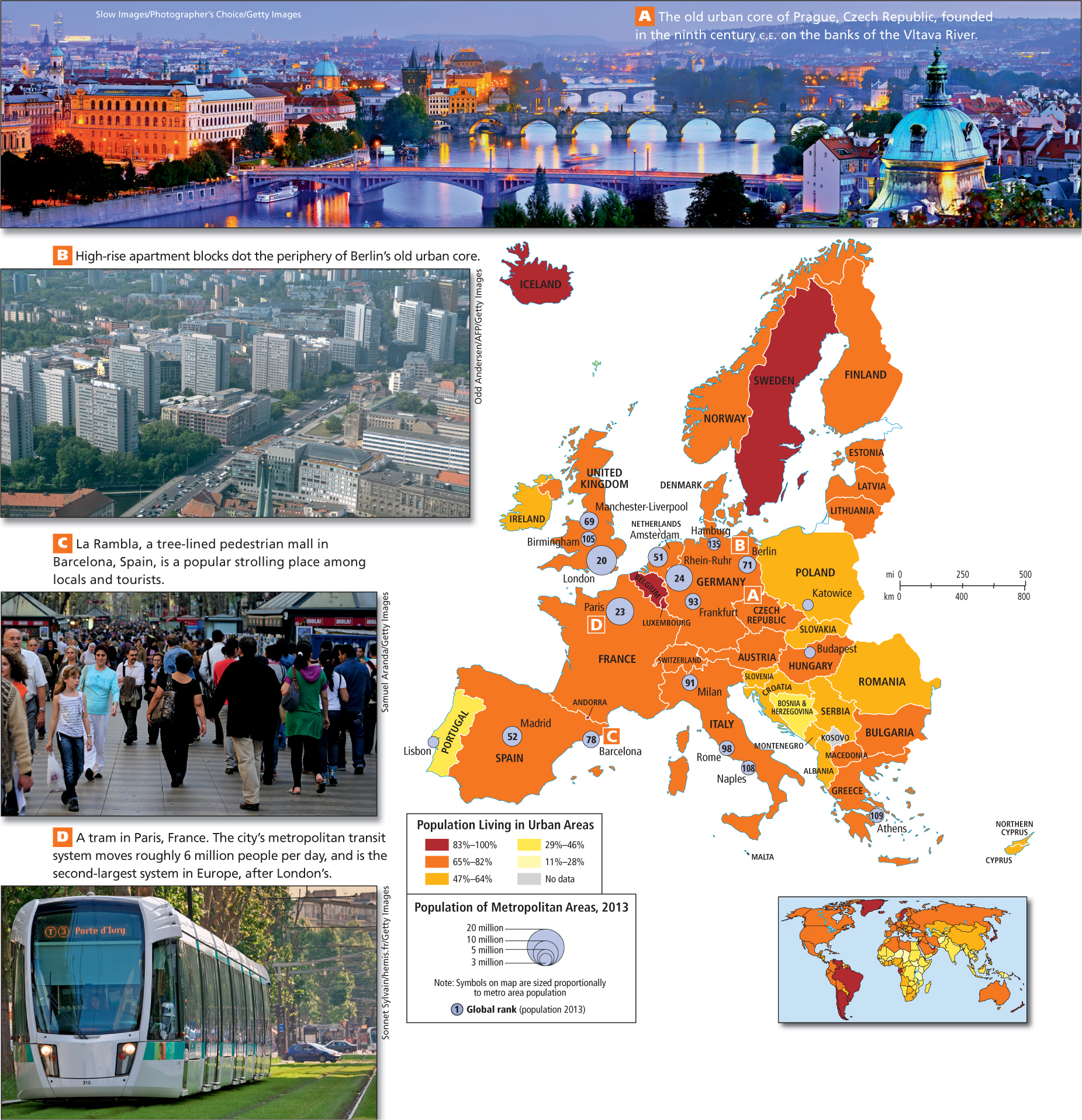4.7 URBANIZATION
GEOGRAPHIC INSIGHT 4
Urbanization: Europe’s cities are both ancient and modern, with old town centers now surrounded by modern high-
Though historically based on trade and manufacturing, most European cities are now primarily service oriented. With many ancient educational and research institutions, urban Europe now has numerous hubs of innovation in the knowledge-
Many European cities began as trading centers more than a thousand years ago and still bear the architectural marks of medieval life in their historic centers (Figure 4.20A). These old cities are located either on navigable rivers in the interior or along the coasts because water transportation figured prominently (as it still does) in Europe’s trading patterns.

THINKING GEOGRAPHICALLY
Use the Photo Essay above to answer these questions.
Question 4.18
oPOdvuxLRkP8FrfCVU4e+L+uEK/6lQ8PX1bmG+haYW7HBmprdH4n+4eudkyg/ylg8Bi5DUjpYJ6wEWBS3zDfJol24T3fsqdSFOMQESRiypgqZp7UUyIZWg==Question 4.19
/cEz2QieAJOOdeIDybcZkrY2+x3+GD1flL1YjVmY7H25wlSgtTXXXmmWSaZpOcYA6Jp6RF0efBXhubobP5vHcKADzX42ljIAynfFNqKekau4uEroth5EfzVqpTyS55Vzy7rtsiTrYb0+PlU1Ax/UBOEKv18=Question 4.20
6E1/8O6sueRv4QFmWyS6Gg5yv/O265oUyfItKy9F5ZYX4YWU/o1D3SBlJx8Tbgbe/v5FRx/LyDIj/u5cnHqWQV9ipvqN437NGadPgtHuazRGIosotcTiC2FhEUTLm3PIZED0YZ/qXHgcv6qqzPnPyXWZDs0zF1tQyyIyGKkcVxkINCguu+qRVa1mj/zBKDBfwifSgxSEVfXt5j9uozPYnUvz2yQpZL6OAY3Dp8bk5fM=Question 4.21
4t/vw8CXdqVfqj9TJt4Jwb6jxfOcU+fWzmbNMT6zOol5sRZfBWIAypRGAutH/J3nTE7Q72EDClhfzN7kpug6O56D8z9S5walPptKup6g0spuCjm39ZEFGlKNl2WXRhi2MhKsF2kemT6mWmZS26Slz70sujiPVNZ+RX5N86Q6nNp6tRvg59Yp1yshTTgzuATYRqqwaduYmLjIDZuKvEcxKOeDbbzmbFb9wFeKTRUChz1u7rtO2M7WiFVB7SkV2WYkE0l5v3Bcu9/qECduSxIwNrwsmzcuo8N9qEcxs7UebbeUoHsMwLzPtAvxW5AeprYFljLCxogg7iD/F29Yr5AwSGTP/3PfwUDSSince World War II, nearly all the cities in Europe have expanded around their perimeters in concentric circles of apartment blocks (see Figure 4.20B). Usually, well-
Although deteriorating housing and slums do exist, especially in the poorer cities and towns of Central Europe, substantial public and private investments in housing, public transportation, sanitation, water, and utilities mean that most people maintain a generally high standard of urban living.
THINGS TO REMEMBER
GEOGRAPHIC INSIGHT 4
Urbanization Europe’s cities are both ancient and modern, with old town centers now surrounded by modern high-
rise suburbs and supported by world- class urban infrastructures. Cities are the heart of Europe’s economy, politics, and culture, with more than 70 percent of the EU population living in urban areas. Though once based on industry and manufacturing, most European cities are now primarily service oriented.
Many older cities are located either on navigable rivers in the interior or along the coasts because water transportation figured prominently (as it still does) in Europe’s trading patterns.
Since World War II, nearly all the cities in Europe have expanded around their perimeters in concentric circles of apartment blocks.
Land is scarce and expensive in Europe, so only a small percentage of Europeans live in single-
family homes, although the number is growing.